Your expert guide: Cenotes in Homun and Cuzama

Most people visiting Mérida will plan to visit a cenote or two, whether it’s to cool off during the hot season or simply out of a desire to see these geological marvels for themselves. Many of the best and most accessible swimmable cenotes near Mérida are located about 1 hour from the city, around the small towns of Homun and Cuzama.
In this article you’ll find a list of the cenotes in Homun and Cuzama we think you’ll enjoy visiting as well as suggestions for getting ther. It’s perfectly possible to visit more than one in a day whether you’re on a tour or exploring alone.
There truly is nothing quite like the feeling of swimming in refreshing crystal-clear pools within the earth. Visiting a cenote is one of the best things you can do on a hot day in the Yucatan. Prepare to be amazed!
There are affiliate links in this article. If you click and make a purchase I could make a small sum at zero cost to you. Thank you!
What is a cenote?

💦 The word cenote (pronounced se-no-tay) comes to us, via Spanish, from the Mayan word ‘dzonot‘, meaning ‘sacred well’.
💦 Geologically speaking, a cenote is a sink-hole caused by collapsing limestone bedrock, exposing the groundwater below. The Yucatan Peninsula is absolutely covered with cenotes. There are thought to be as many as 6000 across the peninsula but barely half have been officially explored and documented.
Different forms of cenotes
There are four types of cenote:
Open – these can resemble lakes and ponds. Generally near ground level. The most ancient cenotes are fully open.
➡️ Nearer to Tulum and Playa del Carmen you’ll find fully open cenotes. There are also some near Progreso and Valladolid.
Semi-open – not entirely covered. This may mean small openings that allow shafts of light to enter, larger openings for stairs as well as cenotes that are part cave, part open.
➡️ Around Mérida, Valladolid and the centre of the Yucatán Peninsula you find many semi-open cenotes.
Deep open – no cave roof, requires steps down to reach the water.
➡️ Mostly found in the centre of the peninsula, around Valladolid and Chichén Itzá. Also in Quintana Roo. The biggest deep open cenote is found a short drive from Valladolid.
Closed – a full cave experience.
➡️ Most of the cenotes you’ll visit from Mérida, including those in Homun and Cuzama are closed cenotes.
The evolution of cenote tourism
As more people visit the Yucatán Peninsula, cenotes receive more and more visitors each year. For the Maya people, cenotes are sacred spaces, an entrance to the underworld, as well as access points for life giving water in this hot region. It is important to remember this as you swim, play and relax in these magical watering holes.
A decade ago, cenote tourism was much smaller than it is today: you could swim in a wild cenote for just a few pesos, free from rules and the trappings of tourism. Today, it is generally required to wear a life jacket to swim in a cenote, you’ll often be asked to shower first and to not wear sun-screen while in the water.
Depending on where you are on the peninsula, the price to enter a cenote ranges from $100 pesos in rural Yucatán to $10-15 USD around the Quintana Roo cities of Tulum, Cancun and Playa del Carmen.
Visiting cenotes
Every cenote is different so don’t assume that because you’ve seen one, you’ve seen them all.
🩱 When visiting cenotes is recommended to wear comfortable clothing, avoid using sunscreen or insect repellent, and bring bottled water, snacks, snorkeling gear, a change of clothes and a towel.
💰 Be sure to take plenty of cash as you’ll need to pay for your cenote entrance fees and any snacks with cash (smaller notes/bills will be easier to use than larger ones).
Cenote Photography
Don’t forget a waterproof camera or GoPro when you’re visiting the cenotes. I have found that GoPros only work when there’s good natural light – I’ve tried to use mine in cave cenotes and had absolutely no luck at all. A proper waterproof camera might have more success in the closed cenotes.
✅ Read more about what to take when visiting a cenote
✅ Read more about visiting cenotes with children
Cenotes in Homun and Cuzama
How to get there
🚌 To get to Homún from Mérida by public transport, take a colectivo (small bus) from the parking lot on C.52 x 65 y 67, Centro. The colectivo departs when full, which is approximately every half hour.
The short drive takes about 1 hour and costs around 35 pesos. Once near your destination, ask the driver to stop. Note that the last colectivo back to Merida is at 6 pm.
🚗 By car, take the Mérida-Cancún highway and then take the detour towards Acanceh (stop here to explore the beautiful Maya archaeological site). Carry on following signs to Cuzuma, Homun is just beyond.
Once you reach the small town of Homun, you’ll need to get on road 10 towards Huhi and look out for signs on your left to the cenote circle (anillo de cenotes).
Planning your trip to the cenotes in Homun and Cuzama
Keep in mind that this article doesn’t cover all the cenotes, just the main highlights, the cenotes we love the best. ‘New’ cenotes are popping up all the time: these aren’t new-new, of course, but rather are newly opened to the public.
🗺 Even if you arrive with a plan, you may end up taking a delightful detour off the beaten path to another cenote that grabs your attention.
Option 1: Guides and tours
👣 One of the best ways to discover the cenotes of Cuzama and Homun is on a guided tour, particularly if you don’t have access to a car or don’t feel confident in your Spanish.
➡️ Check Get Your Guide to see what sort of tour options are available or read the Mexico Cassie guide to the best cenote tours from Mérida
Homun guides
🛺 If you do have a car it’s also easy to pick up a guide in Homun. They can take you, either in your car or in a tuk-tuk, to explore the cenotes around town.
➡️ With a tuk-tuk tour you’ll probably manage 3 or 4 cenotes and lunch. We recommend arriving as early as possible (before 10 am) to maximise the fun. Each tuk-tuk tour costs around $400 pesos and can carry up to 4 people. The tour will generally include the ride to the cenotes and a life jacket. You’ll have to pay to enter each cenote separately though – usually around $100 pesos per person.
Cuzama guides/tours
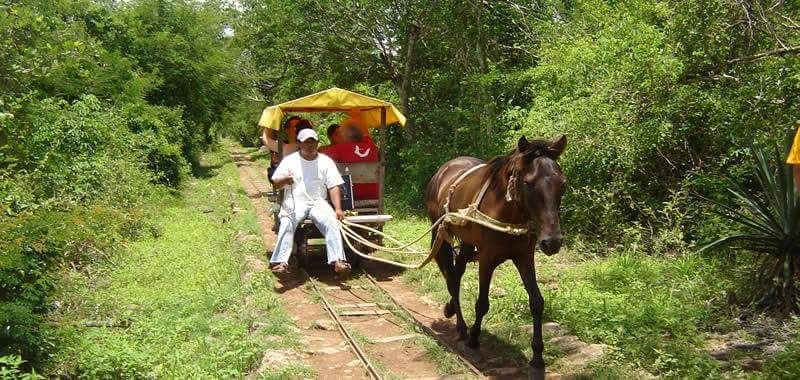
🐴 Cuzamá is a small village famous not only for its cenotes but also its tours. The Cuzama cenotes are accessed via a horse-pulled wagon along an old railway line. They are remote and can only be accessed by dirt trails through the jungle, and the journey is really part of the adventure.
Less touristic than Homun, come here if you’re craving an adventure immersed in natural beauty. Just note that the entrances can be challenging, you’ll have to go down steep stairs and ladders – for this reason we don’t recommend Cuzama for nervous first time cenote visitors, weaker swimmers or young children.
➡️ Read more about the perfect first time / child-friendly cenotes.
💦 The most well-known tour route from Cuzama is called “Los Tres Cenotes de Cuzamá” and it features three stunning cave-like cenotes (listed below).
➕ Other worthwhile horse-drawn cart tours in the area include “Los Tres Cenotes de Chunkanán” and the “Ecotours X’Tojil” tour (use these names to locate their parking lot entrances on google maps). Each of these tours offers access to 3-4 cenotes.
Option 2: Drive yourself
🚗 Take a rental car and drive yourself around the cenotes of Homun and Cuzama. If you use the information in this article you will have a great day exploring the cenotes.
📌 It can be very hard to take good quality photos inside cenotes due to the lack of natural light / having too much fun to always focus on taking blog worthy photos. Hence, there are relatively few photos compared to other Mexico Cassie articles.
Cuzuma Cenotes
Cenote Chan Ucil
⭐️ A closed cenote, its entrance is marked by a large tree. Metal stairs lead to a cave featuring impressive stalactites and stalagmites, ending in a small, crystal-clear blue water cenote.
Cenote Chacsinicche
⭐️ A semi-open cenote great for swimming with a large tree at the entrance and roots extending into the water. There’s a platform for jumping and clear waters where stones are visible at the bottom.
Cenote Bolonchojool
⭐️ A breathtaking cave cenote ideal for diving, this one is accessed through a very narrow opening with metal stairs. It features impressive stalactites and a ceiling with holes for sunlight to stream in. Tree roots reach down to the crystal-clear waters, creating a serene and mysterious atmosphere.
If you’re travelling to Yucatán with kids, don’t forget to pick up a copy of Mexico Cassie’s family friendly guide book to Yucatán.

Homun Cenotes
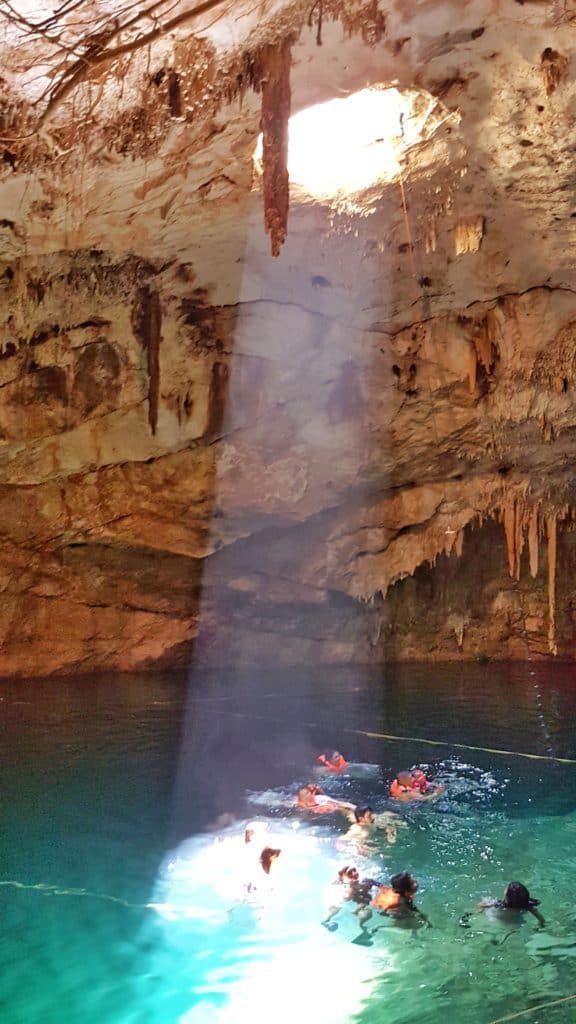
Cenote Tza-Ujun-Kat
⭐️ A popular public cenote that’s easy to get to yourself as it’s just off the main road. It’s a closed cenote with a hole in the top through which sunlight streams through. The spacious interior features stalactites, stalagmites, and shallow areas of water ideal for children.
Cenote Pool Unic
⭐️ A small cenote in a cave, this is across the street from Tza-Ujun-Kat and also easy to get to. Comfortable stairs and shallow water makes this one another good option for families.
Cenote Tres Oches
⭐️ A good choice for the more adventurous, this site features three semi-open cenotes. The first features a small pool surrounded by large stone walls, the second requires visitors to access the cenote through a small opening in the ground, and the third offers a swim between giant boulders, accessible by jumping or climbing down a ladder.
Cenote Santa Maria
⭐️ Another spot for adventurers, this one is a subterranean cenote within a cave. Access involves walking through a narrow stone corridor. The cenote boasts beautiful rock formations and transparent water.
Cenote Yaxbacaltún
⭐️ A semi-open cenote with clear water and vegetation growing on the walls. Visitors can access it either by jumping in or using the staircase.
The following 5 are all along the same dirt road which makes for an easy drive if you have your own car. They are all relatively small and each one unique.
Cenote Bal Mil
⭐️ A semi-open cenote with crystal clear waters and huge stalagmites and stalactites hanging from ceiling. It even has some preserved hand prints on the wall from the mayan era.
Cenote Hool Kosom
⭐️ This one is small but the smooth white limestone ceiling makes it unique. It has an island in the middle and one roof opening for light.
Cenote Wolpoch
⭐️ A closed cenote with stone stairs and a platform offering views of the space, with the roots of a large tree providing a unique seating area for visitors. The cenote here is small and shallow.
Cenote Chulul
⭐️ Another shallow cenote with easy access, this one also has some hand prints on the walls from the Maya era.
Cenote Canunchen
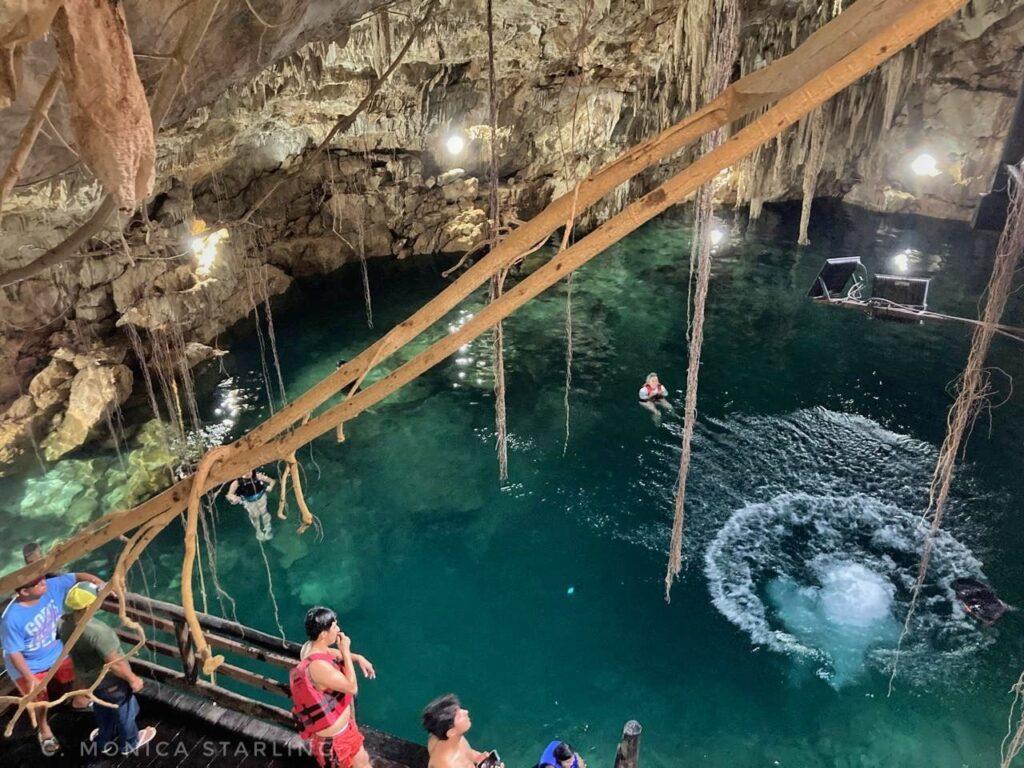
⭐️ This is a really fun one. It has a huge rope swing that is fit for adults and brave kids. There is also a high and low wooden platform to jump off. They have developed the land around this one with trails and palapas, as well as a pool with concrete water slides. This is MexicoCassie’s family’s favourite Homun cenote.
Option 3: Destination cenotes
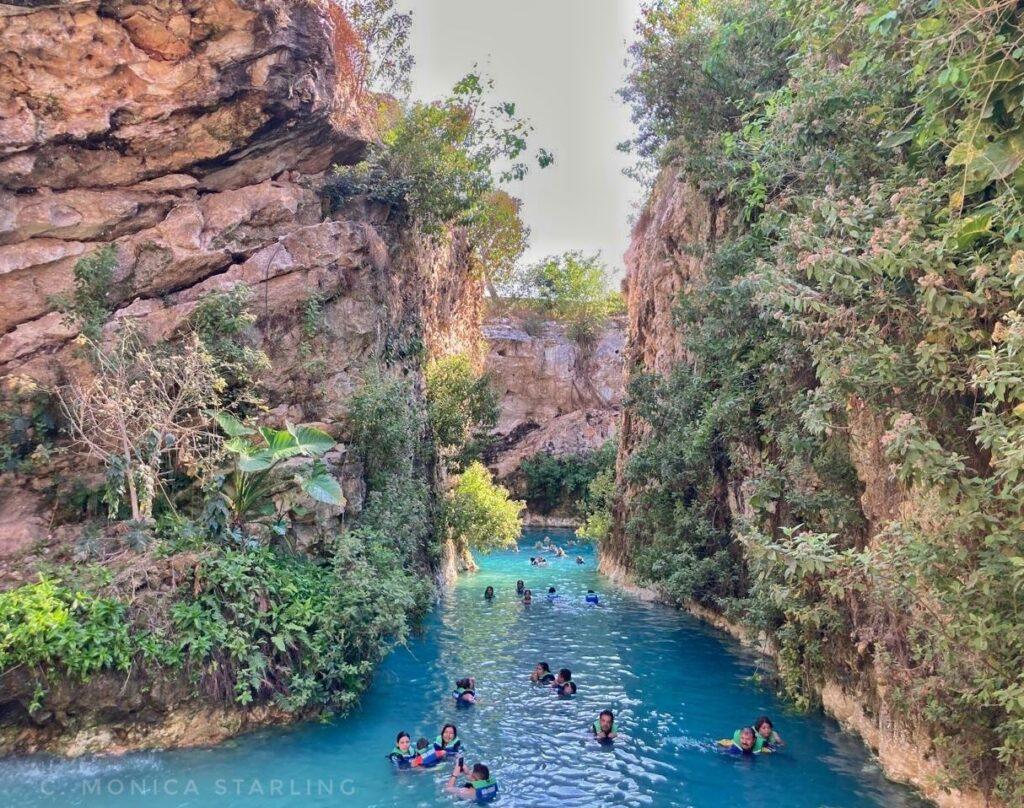
For even more convenience, many cenotes in the town of Homun provide on-site amenities such as restaurants, bathrooms, pools, and even lodging, making this the easiest way to see a few cenotes.
Most of these cenotes do not need to be booked in advance – only Mucuyche absolutely requires it. Others you can just turn up and buy your entrance ticket on the day.
🚗 You can either rent a car or hire a private driver to take you to and from these cenotes.
Cenotes Santa Barbara
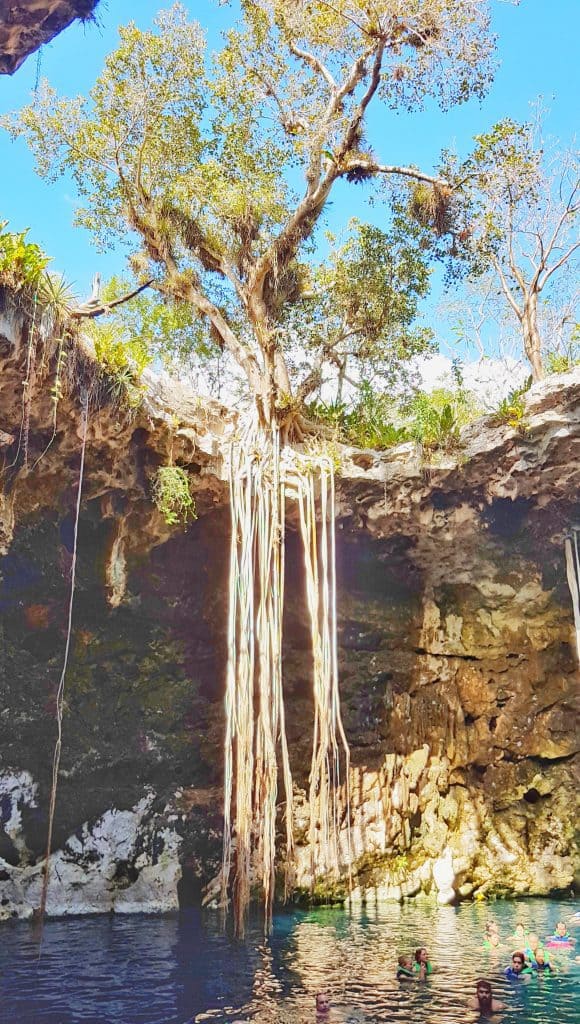
⭐️ A popular destination for first-time visitors to Yucatán, this site has four cenotes, each distinctly different and beautiful, all in once place. It is a fairly touristy site, there are lifeguards, everyone is required to wear a life jacket, and there is a restaurant and a water play/splash pad.
The entrance fee here (depending on the paquete you choose) includes all cenotes and transport between the entrance and the cenotes by a little train.
➡️ Santa Barbara is one of the best day trips you can take from Merida!
♿️ As of 2024, Santa Barbara has the only fully accessible cenote on the Yucatán Peninsula.
Santa Cruz Cenotes
⭐️ If you’re seeking more adventure, here you will find it. Besides their two cenotes (and tours to others), Santa Cruz offers a tirolesa (zip-line), temazcal, and ATV excursions. You can also enjoy the on-site restaurant, pool, cabins, and campsite. The first cenote is semi-open with easy access, and the second cenote is closed with steep stairs and a small cave.
Cenote Santa Rosa
⭐️ For a relaxing day, Santa Rosa offers two cenotes and a restaurant on-site. The first is a large closed cenote, easily accessed by stairs. It is illuminated by artificial purple lights, and there is a platform from which you can jump. The other cenote is a picturesque open cenote which the owners actually excavated themselves. This is a great place to spend the day, as they have excellent facilities and comfortable cabins if you choose to spend the night.
🐶 Santa Rosa is one of the few cenotes to allow dogs on site in Yucatán
➡️ Visit the Santa Rosa website
San Isidro Cenote & Water Park
⭐️ If you’re with kids, this cenote will undoubtedly be their favourite. Not just because it’s an incredible cenote, but because there’s a whole water park built nearby!
Dubbed “La Mini Riviera Maya de Yucatán,” San Isidro has eight pools, a water tunnel, and water slides. It also has a large outdoor area with trails and palapas as well as food service and cabins.
San Antonio Mulix Cenote
⭐️ For a really special experience, here you swim in the cenote after dark. This is a closed cenote on the property of an ex-hacienda, this destination offers a picturesque setting for visitors. Enjoy the restaurant with regional food, and stay overnight in either a room or campsite.
Mani Chan Cenotes
⭐️ This remote destination is the perfect place for a peaceful retreat in nature. The small cavelike access into cenote Mani-Chan is situated in the middle of a campsite. The land has been cultivated with palapas, decorations, grass, pathways, and trees. It also features a hilltop bathroom, fire pit, and food service with local dishes. Two larger cenotes that are definitely worth visiting, Clotilde and Caliskutz, are accessible by walking trail or guided cart. Life jackets are available.
Hacienda Kampepén
⭐️ For the most upscale cenote experience, visit Hacienda Kampepén. The abandoned hacienda surrounded by jungle and 3 incredible cenotes makes for an unforgettable day. They offer food service, guided walking or biking tours, and an area for camping.
Hacienda Mucuyché
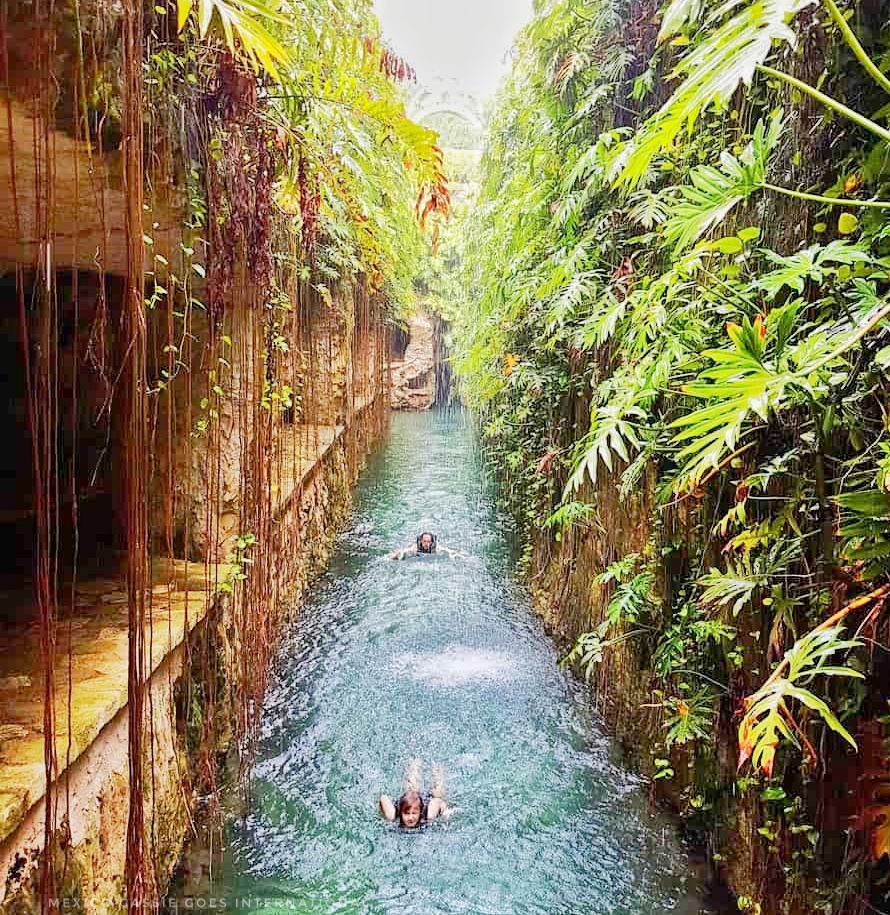
⭐️ Possibly the most well-known and most photographed cenote location on the whole of the Yucatán Peninsula it’s only possible to visit here if you book in advance or sign up to a tour. There are two cenotes, linked by a gorgeous (and artificial) channel that visitors swim down. The tour includes a visit to the hacienda runs, a guided visit through the cenotes and access to the pool and restaurant area.
➡️ Visit the Hacienda Mucuyche website
➡️ To book tickets, send a Whatsapp to 9995476087 or 9996499203 – tours are available in English or Spanish. If you book tickets this way you’ll need to get yourself to the hacienda so a rental car is a good idea. It’s much more economical than a private tour.
Hameki
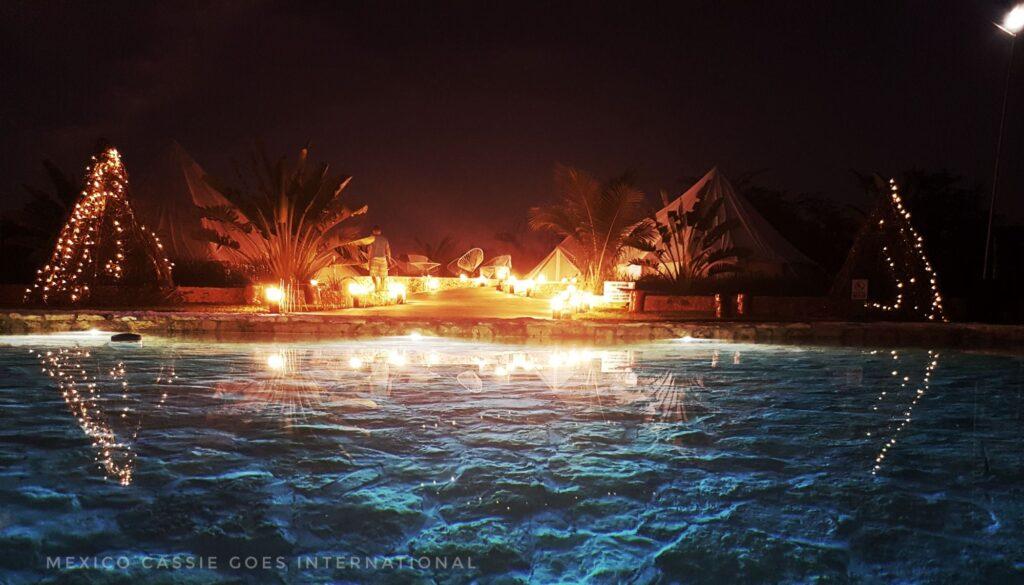
⭐️ This fabulous glamping site in Homún offers tours with local guides to nearby cenotes. With air-conditioned tents, terrace campfires, a pool, restaurant, and trampoline, this makes a great family getaway. MexicoCassie has stayed here a few times and highly recommends it.
Other Mexico Cassie cenote articles
➡️ Cenotes to visit from Mérida
➡️ Cenotes to visit from Valladolid
➡️ Cenotes to visit from Izamal
➡️ The best cenotes to visit after Chichén Itzá
➡️ The best cenotes for nervous swimmers / children


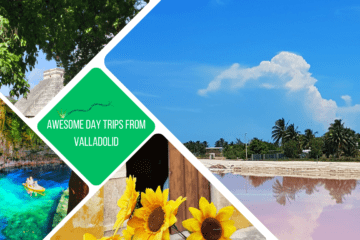
0 Comments